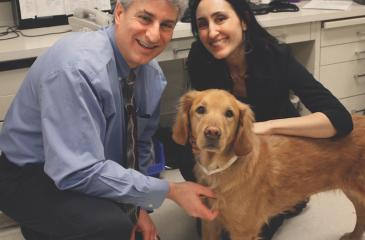Teaming up for treatment: MCC/CVM collab advances cancer research in humans and animals
This original story by Kaitlin Sullivan was first published by the University of Minnesota's College of Veterinary Medicine. Read it on the CVM website.
__________
Al and June Perlman didn’t have children in the traditional sense, but their two poodles meant the world to them.
The Minnesota couple was wintering in Tucson, Arizona, in 1999 when a veterinarian diagnosed one of their beloved dogs with a fast-growing melanoma. The doctor told the Perlmans there was nothing the clinic in Tucson could do, and that making the 25-hour journey back to the Twin Cities to seek care at the University of Minnesota (UMN) was their best bet.
It turned out to be sound advice.
Dr. Dan Feeney successfully treated the Perlman’s dog, prompting the first discussions about establishing a unique partnership between veterinarians and researchers who specialized in cancer at the College of Veterinary Medicine (CVM) and the university's Masonic Cancer Center (MCC). By 2005, the CVM was searching for the inaugural Alvin and June Perlman Chair of Animal Oncology. Their search took them to Colorado, where Dr. Jaime Modiano was already conducting research through a similar partnership. The difference was, there was an 80-mile commute between the University of Colorado Cancer Center, where Modiano worked, and Colorado State University, where the College of Veterinary Medicine & Biomedical Sciences was located.
He jumped at the chance to be a part of UMN’s partnership, but even the short distance between the St. Paul and East campuses created challenges to spark collaboration.
For this to be a true partnership, the CVM labs working on cancer research would need to be housed in the MCC. The move, in 2007, erased the remaining lines that separated animal and human cancer research at the university.
“It’s been a win-win-win all around,” Modiano says.
From humans to dogs and back again
If there was a poster child for how vital this collaboration has been for advancing cancer therapies, both for pets and the humans who love them, it would be a drug called eBAT.
One day during her fellowship in the Modiano Lab, in the spring of 2012, a veterinary medicine student named Dr. Jill Schappa—who is now an assistant professor of clinical pathology in the Department of Veterinary Clinical Sciences at the CVM—took it upon herself to walk the halls of the MCC, curious about the research going on around her. This is when she stumbled upon Daniel Vallera, PhD, a professor of radiation oncology at the MCC and head of the section of molecular cancer therapeutics, who specialized in genetically engineering new cancer drugs. His laboratory was developing a novel cancer therapy called eBAT.
The biological drug enters the body in search of two targets. On their own, these targets are found in healthy organs, but they’re only found together on highly malignant tumors, including one called hemangiosarcoma. Hemangiosarcoma is a cancer that forms when the cells that normally build blood vessels go rogue. By attaching to these targets only when they’re expressed together, eBAT can not only identify cancer, but use these proteins to anchor itself to the tumor in preparation for part two.
Once secure, eBAT enters the tumor cells and releases a genetically engineered toxin that kills the tumor cells. Part of the innovation of eBAT’s design is that it also is able to disrupt the environment that the tumor cells need to thrive, so that even if some tumor cells evade the drug, they will no longer find a hospitable environment in which they can grow.

When Schappa wandered into the Vallera Lab, the drug had only been tested on human tumors in mice—with promising results. She had a hunch it could be also effective at treating cancer in dogs. Schappa asked Vallera if she could take some of the drug back to the Modiano Lab to run her own experiments. With that, a long-standing, life-saving collaboration was formed.
“She was one of those crucial people who helped translate eBAT to veterinary patients,” says Dr. Antonella Borgatti, a professor of oncology in the College of Veterinary Medicine.
At the same time, Borgatti was playing another important role in bridging the gap between human and veterinary oncology. With the help of the prestigious National Institutes of Health (NIH) KO1 award for career development, Borgatti, a DVM, was able to spend 5 years in the Vallera Lab further developing eBAT—and learning techniques and lessons from human oncology that she could apply to veterinary medicine.
“I got to see how some of these drugs are being developed while splitting my time between the vet school and the cancer center,” she says. “I got to experience both worlds.”
Armed with the groundwork laid by the Vallera Lab’s research using eBAT to treat human brain tumors in mice, Schappa was able to help conduct additional research that further hinted at eBAT’s safety and potential efficacy. Then the team was ready to seek approval to use the experimental treatment in dogs with splenic hemangiosarcomas—a type of cancer that had long been the focus of research at the Modiano Lab.
“It's one of those tumors we’ve been interested in because it’s essentially incurable,” Borgatti says.
Hemangiosarcomas usually don’t cause symptoms until late stages of the disease when the cancer has metastasized and spread throughout the body. Often, a dog with this type of cancer will arrive at the emergency room with a ruptured mass on their spleen. If veterinarians can successfully remove the organ, the pet will have about six months to live if treated with existing chemotherapy.
“We’ve been investigating new therapies and different chemotherapy combinations to see if the outcome can be improved with no success. eBAT was a breakthrough treatment, the results of the first trial were very encouraging,” Borgatti says.
These encouraging results have huge implications for human medicine, too.
Large animal models are often required for therapies to advance to human trials, but those present ethical challenges. By trying the treatment in dogs who are already sick and have a bleak prognosis, researchers can gain the invaluable data they need to advance human trials while helping extend the lives of pets.
With the large animal data they need, thanks to the dogs treated at the CVM, MCC researchers are now seeking approval for experimental trials that use eBAT to attack cancer in humans.
Targeting sarcomas
According to Erin Dickerson, PhD, an associate professor of oncology in CVM, exploring treatments that could be useful in both dogs and humans has another advantage: the biological pathologies going on in human cancers are very similar to those occurring in dogs.
Sarcomas—a broad family of cancers that affect soft tissues or bones—are rare in humans, making up about 15 percent of childhood cancers and just 1 percent of cancers in adults. The incidence of sarcoma is higher in dogs and provides a unique opportunity to understand how these cancers, and the drugs that could treat them, work.
Dickerson is part of a group of CVM cancer researchers investigating how metabolic pathways unique to tumors can be targeted to eventually kill the tumor cells. She’s investigating a drug called propranolol, a beta blocker that’s been FDA-approved for use in humans and dogs for decades. In recent years, researchers have discovered the drug, originally used as a heart medication, shrinks a rare blood vessel cancer in people called angiosarcoma.
“Canine hemangiosarcoma is virtually indistinct in terms of its biology and disease progression from human angiosarcoma, so we wanted to see if propranolol would work in dogs diagnosed with hemangiosarcoma,” Dickerson says.
The first stage of a trial that used propranolol in dogs with hemangiosarcoma tested how dogs responded when they received both the experimental drug and the current standard of care, surgery followed by chemotherapy. In a subset of dogs, propranolol in combination with chemotherapy appeared to increase survival beyond what would be expected with standard of care alone, while other dogs did not appear to show additional benefit from the treatment. Although the study is still ongoing, Dickerson and her team are interested in understanding why some dogs appeared to do better than others.
The CVM team is now collaborating with sarcoma experts at MCC to analyze the tumor samples collected from dogs enrolled in the trial to understand why some dogs may have responded to the drug combination while others did not. Results from this analysis have already identified other promising drug combinations.
“Based on what we have learned from the first study, we are now testing new drug combinations in the laboratory. If successful, our goal is to translate our findings first into dogs with hemangiosarcoma and then into human patients diagnosed with angiosarcoma,” Dickerson says. “We couldn’t do this work without the partnership between human and veterinary medicine.”
